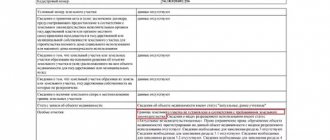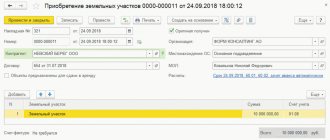Home / Land / Land surveying
To determine the exact boundaries of the site, you will need a complex of works, including geodetic survey and cadastral registration. This procedure is called land surveying and is mandatory. Without it, it is impossible to register ownership of your plot and make transactions with it. You can simplify the procedure if you carry out land surveying through the MFC.
Previously, its design did not require defining boundaries, which led to disputes and conflicts. Land surveying makes it possible to eliminate such situations, since the coordinates are recorded in documents and agreed upon with all neighbors. Starting from 2018, all owners must draw up a boundary plan.
What does a boundary plan look like?
The boundary plan consists of 2 parts: text and graphic. Each part is designed completely differently. The text and graphic parts are divided into sections that must be included in the boundary plan. The list of included sections depends on the type of cadastral work being carried out. In this case, the boundary plan must have a title page and content.
The grafical part
The graphic part should also include descriptions of approaches to the land plots being formed, that is, travel routes to the land, passages to the land plot from land plots related to public lands. Access routes to a land plot must be reflected in the boundary plan, even when such routes are established using the easement method (limited right of use).
The graphic part will contain the following sections:
- geodetic construction plan;
- land location plan;
- diagram of land plots and their parts;
- outlines of nodal points of land boundaries.
Text part
The text part of the boundary plan of a land plot contains information entered into the real estate register about this land. The quantity and volume of information entered is established by regulations issued by cadastral regulation bodies at local levels. In the manner and in cases provided for by the legislation of the Russian Federation, the boundary plan must contain an act of approval of the location of the boundaries of the land plot.
The text part includes the following sections in their exact form in accordance with the legislation of the Russian Federation:
- initial data;
- information about measurements and calculations performed;
- information about the land plots being formed and their parts;
- information about changed land plots and their parts;
- information about land plots through which access to newly formed or changed land plots is provided;
- information about the specified land plots and their parts;
- information about the formed parts of the land plot;
- conclusion of a cadastral engineer;
- act of agreeing on the location of the border of a land plot.
Land surveying is paid directly by the person who ordered such a service. The price of drawing up a boundary plan for a land plot can vary significantly depending on the size of the plot, its legal form, the volume of information entered into the land cadastre, as well as the presence of additional work carried out by cadastral engineers.
Contents of the land survey
Land management work, which includes a large number of different activities, must be recorded in some way. That is why the survey file was formed, which has a certain form and structure, requires compliance with the order of presentation of information and its proper execution, otherwise this set of documents will not be considered official and will not be able to help in registering the site and registering it with the land survey service. cadastre.
The main thing when forming a land management case is to avoid violations of the interests of other owners of adjacent plots, otherwise the work will have to be carried out from the very beginning, and on each side of the dispute.
As for the information that should be contained in the survey file, it has certain requirements for its presentation.
The contents of the document in question are as follows:
- A cover that should contain information about the object, its name and address, and also indicate who is the owner of the plot.
- Table of contents of the document for simplified search for specific information.
- Explanatory note of the document.
- A plan, drawn up in the form of a diagram, which includes information about the site contained in the cadastral service system.
- Technical specifications that specialists need for further work on the site.
- Documents that confirm the ownership of the site. Only photocopies of such papers are sewn into the file itself.
- Drawings that form the technical design of the upcoming work and the plot itself.
- Documents that confirm the fact that all interested parties have been notified of the survey work. This is important in the case when the boundaries of the plot are established and the territory of adjacent plots may be violated.
- An act reflecting data on the survey of the boundaries that were previously defined on the site.
- Powers of attorney of those persons who perform boundary work.
- An act that coordinates the established boundaries with those of neighboring areas.
- Coordinates that are assigned to each boundary sign installed on the site.
- The act of handing over the supporting boundary networks in order of supervision for their safety.
- An act recording the fact of acceptance and inspection of survey objects by the specialist performing the work.
- Plan of the established boundaries of the allotment.
- A statement reflecting the exact area of the site and all calculations made.
All information comes in exactly this order.
We recommend that you read:
Permissible error when surveying land plots
The absence of any information will indicate that the survey work was not completed in full, which will not allow the site to be ultimately registered.
A land survey can serve as the basis for both the initial registration of an allotment and, if necessary, making changes to the information contained in the register.
When a land management file is formed, its original is transferred for storage to the archives of the land resources committee. The owner also has one copy in his hands, which he could present without contacting the cadastral authorities when making transactions. If the owner loses his copy of the file, then he can contact the archive and request a copy of the document. In order for the case to be valid and serve as a basis for registering the plot of land, the main thing is to include in it all the information about the owner, the plot and the research carried out, recording everything with the signatures of specialists and transferring it to the authorized body.
Procedure
you need to go to the local branch of the MFC.
A specialist consultant will tell you which coupon you need to take for land surveying.
Then you need to wait until your number lights up on the board and go to the indicated window.
An MFC employee will accept documents for processing.
After which the customer will be asked to select a cadastral engineer from the list provided by the MFC.
An agreement must be concluded with the organization represented by this specialist. The center assumes all mediation work and risks.
The MFC specialist will tell you what time you need to come next time. In this case, the applicant is given a receipt indicating which documents were submitted and the registration number, by which you can find out about the status of the application. The applicant must provide his telephone number where he can be contacted.
How does land surveying work?
The process takes place in several stages. The first is the collection of documents that will be required to conclude an agreement with the organization conducting the survey. If the interests of the owner are represented by another person by proxy, a document certified by a notary is required.
If there are several owners, everyone will have to collect a package of documents. The work is carried out with the participation of all owners of shared property, so it is worth entrusting this to one of them, so that the rest do not need to go to the site.
After preparing the documents you must:
- choose a contractor;
- enter into a contract;
- carry out geodetic work, obtain a boundary plan;
- register the site with Rosreestr;
- register the right to property.
The last two stages can be combined. To do this, you need to take the documents to the MFC.
How to check the quality of services performed by a survey specialist
In other words, how can you make sure that this or that engineer needs to be hired to work with a certain area, so as not to encounter the errors that were written about earlier?
- First of all, you need to make sure that the cadastral specialist is qualified. Qualification will be indicated by the presence of a certificate from a specialist.
- Before concluding a contract, you need to obtain information about a geodesy specialist; this can be done on the Rosreestr website.
- It must be remembered that the activities of engineers in this area are strictly controlled by the relevant government agencies to which they are responsible. They also certify a specialist and test him in a qualification exam.
The most complete information about surveyors is recorded in state registers.
If such a specialist contributes to the introduction of deliberately false information into the text of the documentation, then at best he will face a fine of 5,000 rubles and disqualification for a period of 3 years. All actions of the engineer within the framework of the contract for carrying out all stages of the work can be challenged in the manner prescribed by the legal system.
Let the owners of the plots decide for themselves whether they need land surveying or not. But still, the answer here will be unambiguous and definitely not negative. “The law is harsh, but it is the law,” so the owners are forced to obey its demands, contrary to their previous ideas.
Preparation procedure
Registration of a boundary plan for a land plot occurs in accordance with several stages, which include:
- Preparation for work. At this stage, the purpose of the work is clarified, which helps determine what type of document will be drawn up. At the same time, an agreement is concluded with the customer.
- Analysis of land documents. The cadastral engineer studies all the land documents provided to him by the customer of the work. At the same time, possible errors or inaccuracies that they contain are identified. If the necessary documents are not available, the specialist independently requests them from the relevant authorities.
- Obtaining information from the state cadastre. This information, along with the documents provided by the customer, is also necessary for carrying out cadastral work.
- Taking measurements of the allotment. This stage is already purely practical, when the engineer carries out the field work necessary to establish boundaries. They may not be required in all cases, but only when data from the state cadastre is insufficient or unreliable.
- Coordination of boundaries with neighboring plots. This stage is possible if land surveying is being carried out for the first time or if there are any disputes or disagreements with neighbors. At the same time, the latter are notified at least a month in advance about upcoming work, after which they either give their consent to the establishment of boundaries or provide a written objection.
The result of the procedure is a special document - an act of approval of the boundaries of the allotment, which is signed by all interested parties.
If there is a written objection, a note about this must be made in the act, to which this document is also attached.
Processing the results obtained
At this stage, the engineer processes all the data that he received as a result of land surveying - both the results of field work and cadastral information.
Formation of a boundary plan
Based on the results obtained, the specialist prepares a final document, which is drawn up in accordance with the requirements of land legislation.
Next, the finished plan is issued to the customer, who can use it for the purposes that served as the reason for applying for land surveying. In particular, he attaches it to the application and the rest of the package of documents necessary for registering the site with the cadastral register.
Investments in the construction of residential real estate are a very profitable and profitable type of business. To conclude a land purchase and sale transaction, you will need to prepare a certain package of documents. You can find out what it includes here.
Did you know that you can rent a plot from the administration with a subsequent right to buy it? Read our article for details.
Types of surveying
There are dozens of different types of land surveys: hydrographic survey, topographic survey, geological survey, cadastral survey, building site survey and geodetic survey.
How to properly read a survey plan depends on the type of survey you are looking at. Many types of land surveys contain a lot of detail and are very difficult to understand without prior preparation.
For example, the results of land surveying for construction contain a huge amount of detail, such as the position of fences, buildings, roads, horizontal placement, detailed measurements and much more.
Below we will look at reading boundary plans.
Why is the work being carried out?
Determining the boundary lines of the territory belonging to a citizen is carried out not only in order to find out the area of the plot or register it with the cadastral registration authorities. Land surveying significantly expands the possibilities for using the territory and also allows you to protect the rights of the owner.
Similar work is carried out to easily perform the following actions:
- Conclude a lease or sale agreement;
- Bequeath land by inheritance;
- Build legally buildings on the allotment;
- Resolve conflicts with neighbors in case of violation of boundary lines of property in court and during pre-trial settlement of the issue;
- To cut land, combine plots, or split the property into several parts.
If you have an ownership plan drawn up by specialists, you can easily prove that a particular territory belongs to a specific land ownership, and also protect yourself from the claims of unscrupulous neighbors.
How to register land
It is possible to submit documents through the MFC in order to immediately register the plot and register your ownership. You shouldn’t put it off until later, the form of the document may change, and you’ll have to do it all over again. The MFC has special application forms that must be filled out to provide the service.
The law stipulates that land surveying through the MFC must take place within 10 days, the period begins from the time when the Cadastral Chamber received the collected documents. If registration occurs through the MFC, then the period increases, which is due to the peculiarities of interdepartmental document flow. The employee receiving the documents issues a receipt and sets a date for the visit.
Demarcation of the boundaries of a plot of land is necessary to mark its boundaries, enter information into cadastral registration, and determine the market price. It is mandatory when connecting the site to utilities. A plot of land that has cadastral boundaries can be donated, sold or bequeathed.
How to find out the inventory value of an apartment
Rules for drawing up an apartment transfer and acceptance certificate
Procedure for removing real estate from cadastral registration
All the intricacies of changing a management company in Russia
Apartment insurance for mortgage lending
Using maternity capital to improve living conditions
Form and composition
The boundary plan consists of two main parts, each of which, in turn, is divided into separate sections. They are worth considering in more detail:
Text part
This includes information that is necessary for inclusion in the real estate cadastre.
This part consists of the following sections:
- title page;
- initial data;
- information on measurements and calculations performed;
- information about land plots or parts thereof that are formed as a result of work;
- information about areas or parts thereof that have been changed;
- information about the areas through which access to the changed or created plots is provided;
- data on real estate objects or parts thereof, which are being specified;
- conclusion of a cadastral engineer;
- the act of agreeing on the location of the boundaries of the allotment.
The grafical part
It includes the following sections:
- scheme of geodetic constructions;
- layout of land plots;
- drawing of plots, as well as their parts;
- outlines of nodal points of allotment boundaries.
It is worth considering that the specific composition of each part of the document depends on what kind of work it is the result of.
In particular, some information is mandatory in all cases, while others are entered only in some of them.
Agreement
Cadastral engineers have the right to carry out land surveying. This activity is licensed, so they must have a document confirming the right to perform this work. You need to make sure that the document is available, then conclude an agreement on the basis of which the work will be carried out.
A preliminary consultation will be required; many companies do not charge a fee for it. It is carried out to clarify the list of works, since in each specific situation it may differ. If individual documents are missing, they will tell you which of them and where you can obtain them.
The text of the contract specifies all the conditions:
- list of works;
- geodetic services;
- price, advance payment, method of payment;
- deadline;
- rights, responsibility.
The duration of surveying is usually 2–3 weeks.
Documentation
Before contacting a geodetic company, you must collect documents and certificates. These include:
- passport of the owner of the site;
- title document to confirm ownership;
- certificate of absence of electrical cables;
- certificate that there are no public communications.
Cost of surveying
The final price depends on several factors. It is included in the contract after the specialist has clarified all the details. Of significant importance are:
- remoteness of the area where the object is located;
- land area;
- category of land;
- complexity of the work, its volume;
- additional services, including technical plans for buildings.
The responsibilities of the engineer include:
- checking documentation;
- measurement of the site;
- drawing up a plan and writing a conclusion.
Planning
The rights of owners of neighboring plots should not be violated. The law obliges the owner to notify the owners of adjacent plots about the date of land surveying. This simplifies approvals and minimizes the risk of disputes over boundaries. The owner himself can notify the neighbors. To do this, a notice is written indicating the time of land surveying, on which the neighbors sign. If they refused to attend, this will not prevent the work from being carried out.
If adjacent plots have already gone through this procedure, the owners have a certificate, and there is no need to notify neighbors. The surveyor’s task is to conduct surveys on the ground, finding out the exact coordinates of the points where the direction of the site boundary changes. There is special equipment for this; GPS devices are used to determine coordinates using satellite communications.
Using the data obtained, the engineer draws up a boundary plan. Sometimes you have to request information from the cadastral authorities about the boundaries of neighboring plots. The final stage is when the parties sign an agreement on boundaries. It is signed by the neighbors, the customer and the municipality employee.
Compliance with the requirements prescribed by law and notification of neighbors does not guarantee the absence of claims. If you cannot reach an agreement on the spot, you will have to go to court. He orders an examination, and a decision is made after receiving its results. The land survey plan is made on paper and electronically for Rosreestr. It consists of a description and an image and contains all the information about the site.
Graphic part of the boundary plan
In addition to the text block, the boundary plan includes a graphic part - displaying the obtained information, calculations and measurements on diagrams and drawings. The required sections of the graphic part of the boundary plan Order No. 921 includes a diagram of the location of the object and a drawing of the site or its parts. Additional sections of the graphic block that can be filled in when carrying out certain types of cadastral work include a diagram of geodetic constructions and outlines of nodal points of the object’s boundaries.
Layout of land plots
The graphic part of the boundary plan is drawn up simultaneously for all plots or parts thereof being formed. When clarifying the boundaries and area, the cadastral engineer graphically displays the boundaries of each area being specified. The layout of the sites is prepared on the basis of USRN information containing cartographic data, or using other cartographic material.
When filling out this section, the location of the site is displayed in graphical form relative to adjacent objects and the boundaries of the cadastral division, and the diagram indicates:
- the boundaries of the object on which cadastral work was carried out, as well as the boundaries of adjacent plots;
- boundaries of municipalities or settlements;
- boundaries of cadastral division;
- boundaries of territorial zones, cultural heritage sites, etc.
If a boundary plan is prepared during the formation and formation of a new object, the diagram will reflect lands or areas of public use.
Drawing of land plots and their parts
A drawing of the site or its parts is a mandatory element of the boundary plan. The contents of this block include the following data:
- location of existing, new and defunct characteristic border points;
- parts of plot boundaries, as well as parts of objects;
- designations of land plots and characteristic border points.
When transferring the specified information into a drawing, the cadastral engineer is obliged to use a scale that ensures readability of the location of characteristic boundary points. All created or refined sections, as well as their parts, are displayed on the drawing field. The design of the drawing allows the use of callouts or insets on separate sheets, if necessary to display individual boundary points.
If the boundary plan is drawn up to clarify the boundaries of the site, an approval act is drawn up on the back of the drawing. When filling out the specified act, it is mandatory to indicate the passport data of the copyright holders of adjacent objects, or information about their representatives.
Additional sections of the graphic part
The geodetic construction scheme takes into account the information obtained as a result of site measurements. In particular, this section will include:
- a schematic representation of the object in respect of which cadastral work was carried out;
- location of geodetic base points on the ground;
- location of shooting justification points, etc.
The content of this diagram may differ significantly depending on the methods used to determine coordinates. The most accurate is the method of satellite geodetic measurements, in which the points and base stations of the geodetic basis, as well as the distance from the base stations to the nearest characteristic point of the border, are reflected on the diagram.
Order No. 921 regulates the condition under which the boundary plan includes the section “Outlines of nodal points of the boundaries of land plots” - if the nodal point is located within a radius of up to 40 meters from three or more long-term and clearly identifiable objects (for example, elements of capital construction projects - buildings, structures, etc.). A nodal point is a characteristic point common to the boundaries of three or more land plots. When displaying an outline, the distance to identifiable terrain objects is indicated.
Concept and purpose
The boundary plan is a document that is drawn up on the basis of one of the following documents:
- cadastral plan of the relevant territory;
- cadastral extract about a specific land plot, which is issued from the Unified State Register of Real Estate.
The boundary plan reproduces certain information presented in the Unified Register, as well as information about the land plot being formed or part of it, and other data necessary for entry into the Unified State Register.
It is compiled by a cadastral engineer and is the result of cadastral work that is carried out in relation to the site in the following cases:
- the emergence of one or more new land plots as a result of division, consolidation or redistribution;
- formation of part of the site (with an easement);
- allocation of an independent allotment from lands that are in municipal or state ownership;
- clarification of the location of the boundaries of the property or its area;
- correction of a cadastral or registry error that is included in the state cadastre information;
- the emergence of a new site due to the allocation of a share or shares in the right of common use;
- clarification of part of the allotment, etc.
This document may be required to be submitted to the registration authority along with the application for the following reasons:
- registration of one or more land plots with cadastral registration;
- accounting for part of the site (including when establishing an easement);
- taking into account some changes that have occurred with the plot (for example, when clarifying its boundaries, area, as well as for the purpose of correcting cadastral or registry errors).
Depending on the purpose for which it is drawn up and what work is being carried out, the content of the boundary plan and its specific type may differ significantly.






